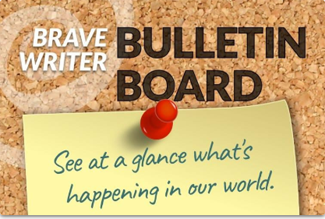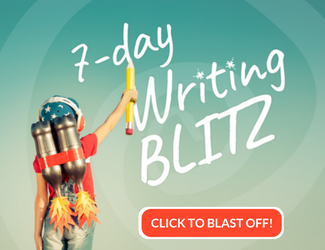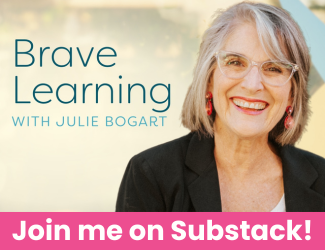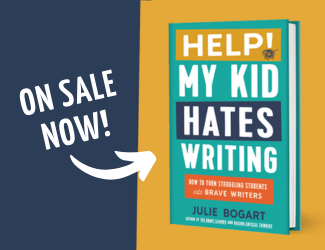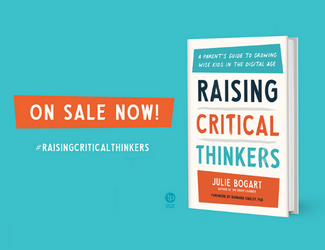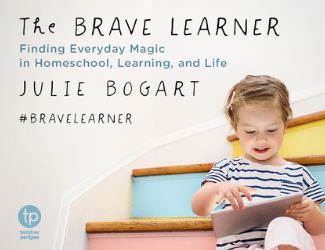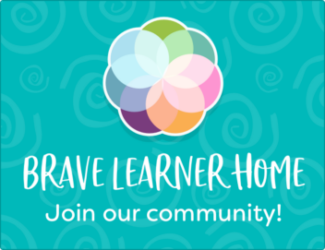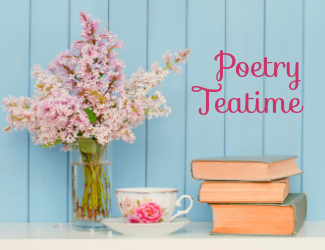
Make Grammar, Punctuation, and Spelling Stick—with Books!
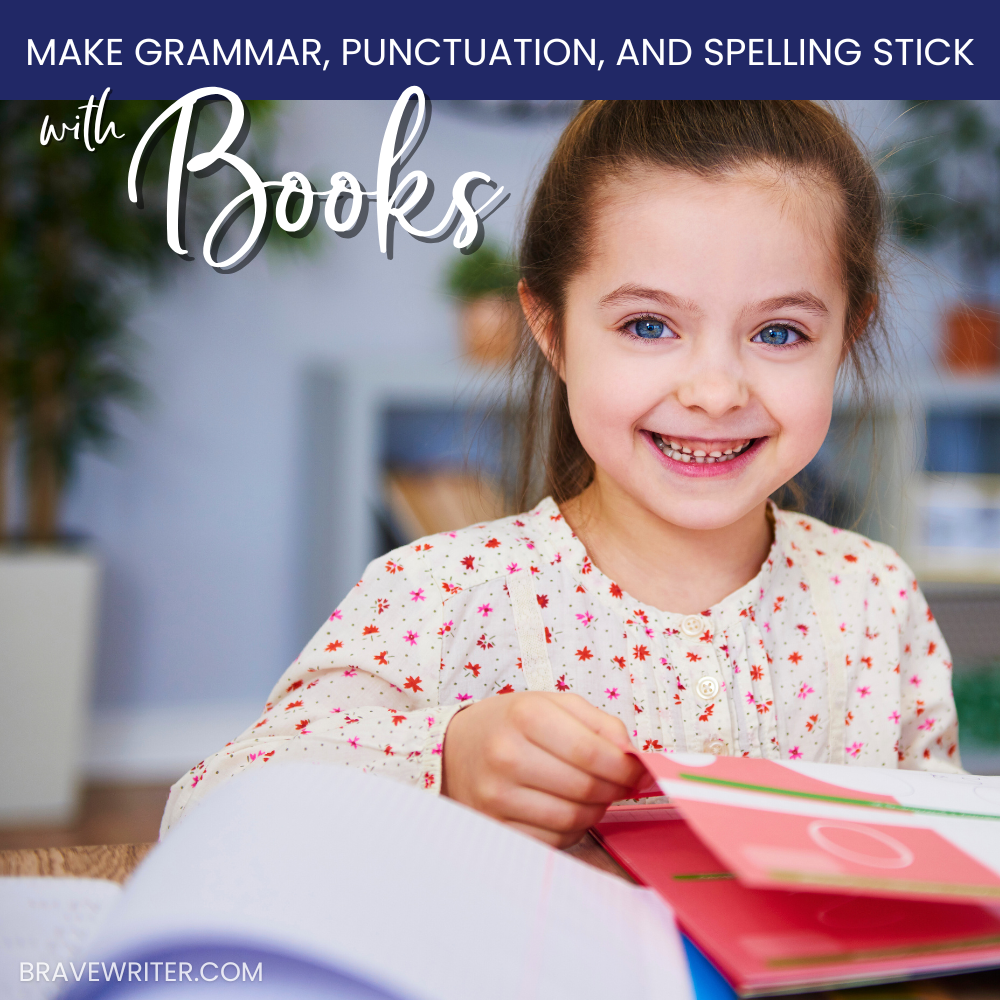
When Brave Writer kids and their parents came to a webinar I hosted (replay below!), I asked the kids if they had ever learned anything on their own that required them to fight through challenges when it got hard.
You know what happened?
They immediately filled the chat with all the wild variety of stuff they’ve learned while beating frustration and overcoming struggle:
Coding, LEGO, knitting, how to hold a pencil, video games, how to use flint and steel, swimming under water, playing drums, origami, cooking, whistling…and so many more!
They were PROUD of their self-will and determination.
When kids care, they will fight to complete the task—even persisting past pain points.
What we’ve learned in Brave Writer is that all the content you want your kids to learn can be passed on through conversation, activity, and your natural relationship with your child. They will learn about plot devices and adverbs because they will WANT to know!
We help traditional writing and literature be as meaningful to kids as whittling wood or Minecraft.
We even give you the tools to make it easier for you. You’re not inventing from scratch. We give the turbo boost to make you effective.
Our objective is to get your kids to care—about prepositional phrases and assonance and mood and setting and characterization and foreshadowing.
I highly recommend watching the replay of our “Make Grammar, Punctiation, and Spelling Stick Using Literature” webinar WITH your kids of all ages so you can see what I’m talking about.
To watch other replays for our special kids’ webinars (Fairytales for All Ages, Headlines—History + Writing + Journalism, Song Lyrics, and Art Appreciation), join our Brave Learner Home community!
[Podcast #318] For the Kids: Meet the Lighthouse Family
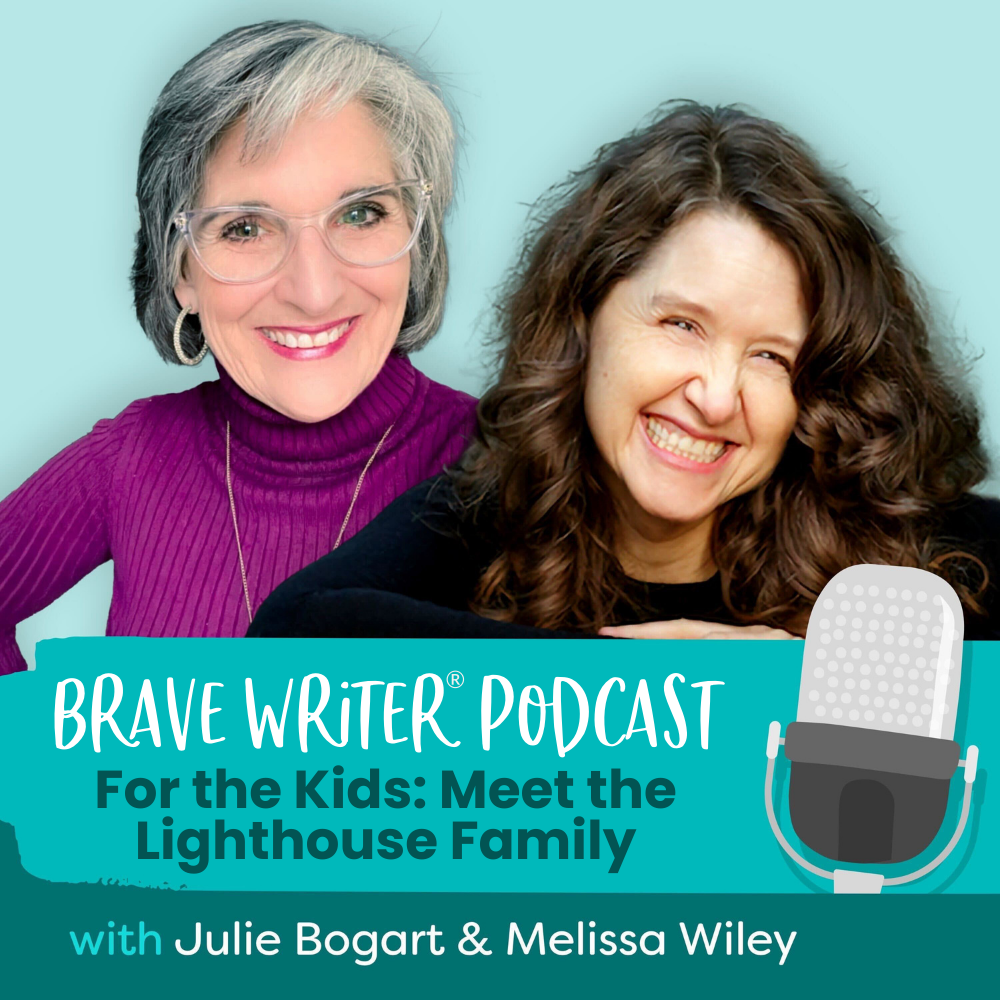
What happens when we slow down and really listen to the language of a story?
In this special Brave Writer podcast episode for kids and parents, we cozy up with Cynthia Rylant’s Lighthouse Family series and unpack a delicious opening passage from The Storm. We notice how sound, mood, adjectives, and even compound words work together to paint Pandora the lighthouse cat’s lonely world—and we share simple ways to turn those discoveries into:
- copywork,
- scavenger hunts,
- and rich family discussion.
Join us as we read, notice, and play with language—then keep the magic going in your own read-aloud time.
Show Notes
One of our favorite things to do as home educators is to read aloud with our kids. But there’s a subtle shift that can turn a simple storytime into a rich apprenticeship in writing: reading like writers.
- Why this word and not that one?
- Why start the story here?
- Why does a single sentence feel so sad or so thrilling?
Those questions aren’t just academic; they’re invitations into craft.
The Power of a Single Sentence
Take a sentence like “She found herself sighing long, deep, lonely sighs.” We meet a character who is isolated, but instead of being told “She was very lonely,” we feel it in our bodies. The repetition, the commas, the triple stack of adjectives—it all creates a slow, weighted rhythm.
When we read like this with our kids, we can pause and ask: What makes this sentence so powerful? How would it feel if we changed one of those adjectives? What if we took the commas out? We’re not administering a quiz; we’re inviting curiosity. Our children learn, almost by osmosis, that word choice and punctuation carry emotion.
Playing with Sound
Sound devices like alliteration, assonance, and consonance can seem like abstract literary terms until you hear them working in a story. “In a lonely lighthouse, far from city and town, far from the comfort of friends…” rolls off the tongue like a gentle wave.
Instead of handing our kids a definition, we can point to the line and say, “Do you hear all those L sounds? How does that make it feel?” From there, we can play: try writing our own description of a place using repeated sounds, or go on a “sound scavenger hunt” in today’s read-aloud. Learning becomes a game instead of a worksheet.
Seeing the Story Beneath the Story
We also love to notice how authors handle time. A flashback, for example, doesn’t just fill in backstory; it reveals what matters most to a character. When a writer drops us into a memory of a storm at sea and a ship saved by a lighthouse, we see why tending a light later becomes a vocation of the heart.
These are beautiful conversations to have with our kids: What is this character afraid of? What do they love? How does the past explain who they are now? Suddenly, reading isn’t only about plot; it’s about empathy.
Turning Noticing into Practice
All this noticing naturally spills into our children’s own writing. Once they’ve hunted for compound words in a chapter book, they start inventing their own. Once they’ve collected homophones, they delight in spotting them in the wild. Once they’ve experienced how a powerful verb like “howled” or “crashed” changes a scene, “said” and “went” start to feel boring.
We don’t have to lecture about any of this. We simply:
- keep reading aloud, pausing now and then to marvel together,
- ask big, juicy questions,
- and treat literary devices like a spice cabinet we can open and smell.
Over time, our kids internalize what good writing feels like. And when they sit down to write—even if it’s just a sentence or two at first—they have a rich store of rhythms, images, and structures to draw from.
That’s the quiet magic of reading like writers: we aren’t just passing the time or checking off a language arts box. We’re building a shared language of craft and a lifelong love of stories, together.
Resources
- Order the Lighthouse Family issue of the Dart here (available Jan. 1, 2026)
- Find the Lighthouse Family books in the Brave Writer Book Shop
- Brave Writer class registration is open!
- Visit Julie’s Substack to find her special podcast for kids (and a lot more!)
- Purchase Julie’s new book, Help! My Kid Hates Writing
- Find community at Brave Learner Home
- Learn more about the Brave Writer Literature & Mechanics programs
- Start a free trial of CTCmath.com to try the math program that’s sure to grab and keep your child’s attention
- Subscribe to Julie’s Substack newsletters, Brave Learning with Julie Bogart and Julie Off Topic, and Melissa’s Catalog of Enthusiasms
- Sign up for our Text Message Pod Ring to get podcast updates and more!
- Send us podcast topic ideas by texting us: +1 (833) 947-3684
- Interested in advertising with us? Reach out to media@bravewriter.com
Connect with Julie
- Instagram: @juliebravewriter
- Threads: @juliebravewriter
- Bluesky: @bravewriter.com
- Facebook: facebook.com/bravewriter
Connect with Melissa
- Website: melissawiley.com
- Substack: melissawiley.substack.com
- Instagram: @melissawileybooks
- Bluesky: @melissawiley.bsky.social
Produced by NOVA
10-Step Homeschool Routine

Homeschoolers want a schedule! I want you to have a routine. But you can call it a schedule if that makes you happy!
I’ve learned that I can keep a routine more easily than a fixed schedule.
I laid out our family’s 10-step routine on Instagram stories and many asked me to share it permanently.
Here it is!
- Wake up after enough sleep (time of day varies).
- Spend 30 minutes or so—getting breakfast, drinking tea or coffee, kids playing.
- Brush teeth and dress.
- Move to the family room for read aloud time (usually several books over the course of an hour that includes myriad interruptions by toddlers, baby nursing, juice getting, or ending a fight over LEGO).
- Take a break—run around the house or backyard then eat a protein snack.
- Gather at the kitchen table for copywork, handwriting, working on a writing project.
- Another break—toss a frisbee, do jumping jacks, have a dance party.
- Do math at the kitchen table. If a toddler is a problem, park them in front of the TV for a show you like while guiding the other kids in math.
- LUNCH!
- History/Science/Arts after lunch. Pick one each day. Rotate.
That’s it! That’s the routine. With a range of ages, you might sometimes need to alternate attention. That’s okay! Let the child who isn’t working with you do something fun they can only do during those times. It helps!
But above all…
Drop everything for a better offer! Field trip, park day, museum, skiing, going to the beach, binge watching a great TV series.
My book, The Brave Learner, goes into detail about how to
create a lifestyle of learning. We’ve got you!
Reading Aloud Changes Everything
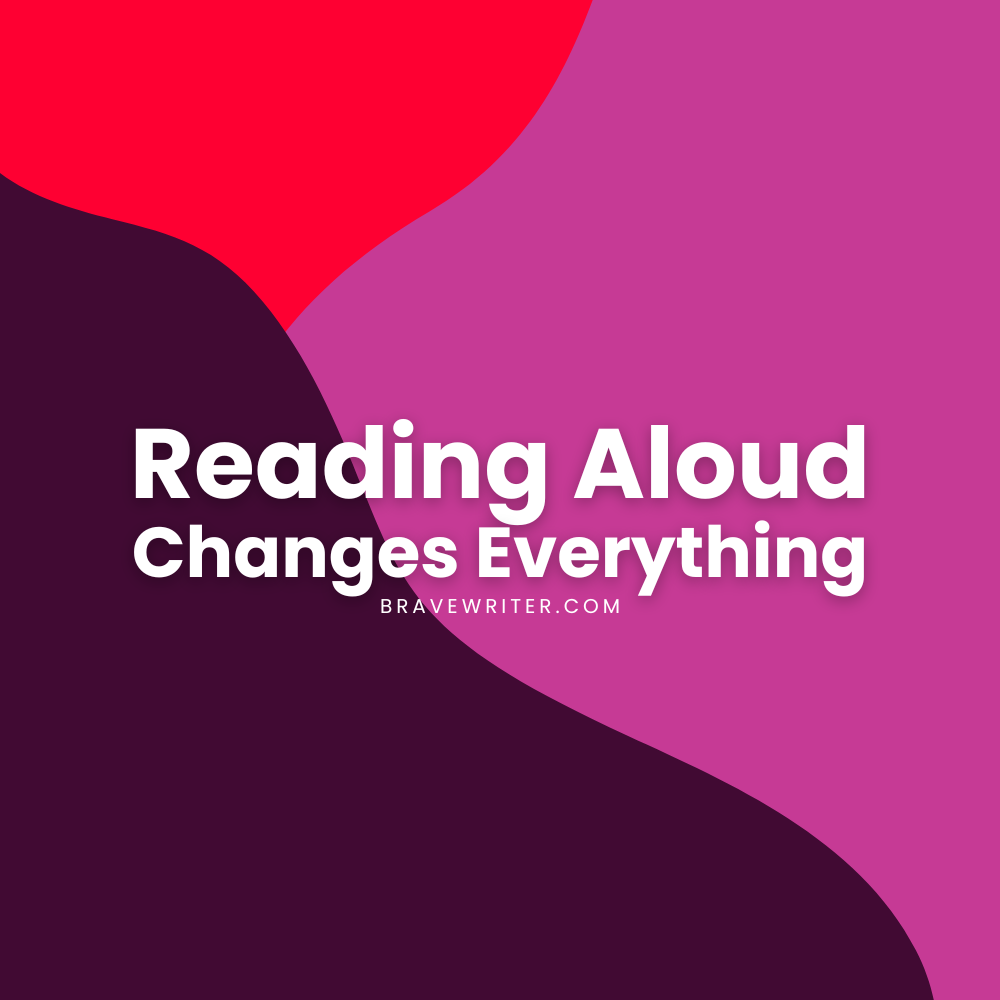
Did you miss our “Reading Aloud Changes Everything” webinar? It was raw. I found myself sharing personal stories of Morocco and the role of reading in my life as a child. Sometimes the scope and length of life catch me by surprise, and I realize how sacred books have been in making me into the person I am today.
But even more, I’m aware of how books have shaped informed the people my children have become as adults. They have values and sensitivity and facility with language because we spent so much time immersed in literature.
Living Books
In this moment of AI and digital decay, LIVING books are the answer written by human beings who crack open their hearts to let you see their interiors.
It is such a privilege to read a writer who takes that risk. We give that gift to our children every day when we read to them. Wow.
Watch the replay.
About Brave Writer
Brave Writer products are written by real people who love literature and understand how to engage children so that the leasons of literature stick with them.
We are different than other programs for a reason. And it’s effective as well as delightful as a result.
Throw off the school ideas—that’s why you decided to homeschool!
Join us. We walk with you the whole way.
[Podcast #317] Hygge Homeschool for the Holidays
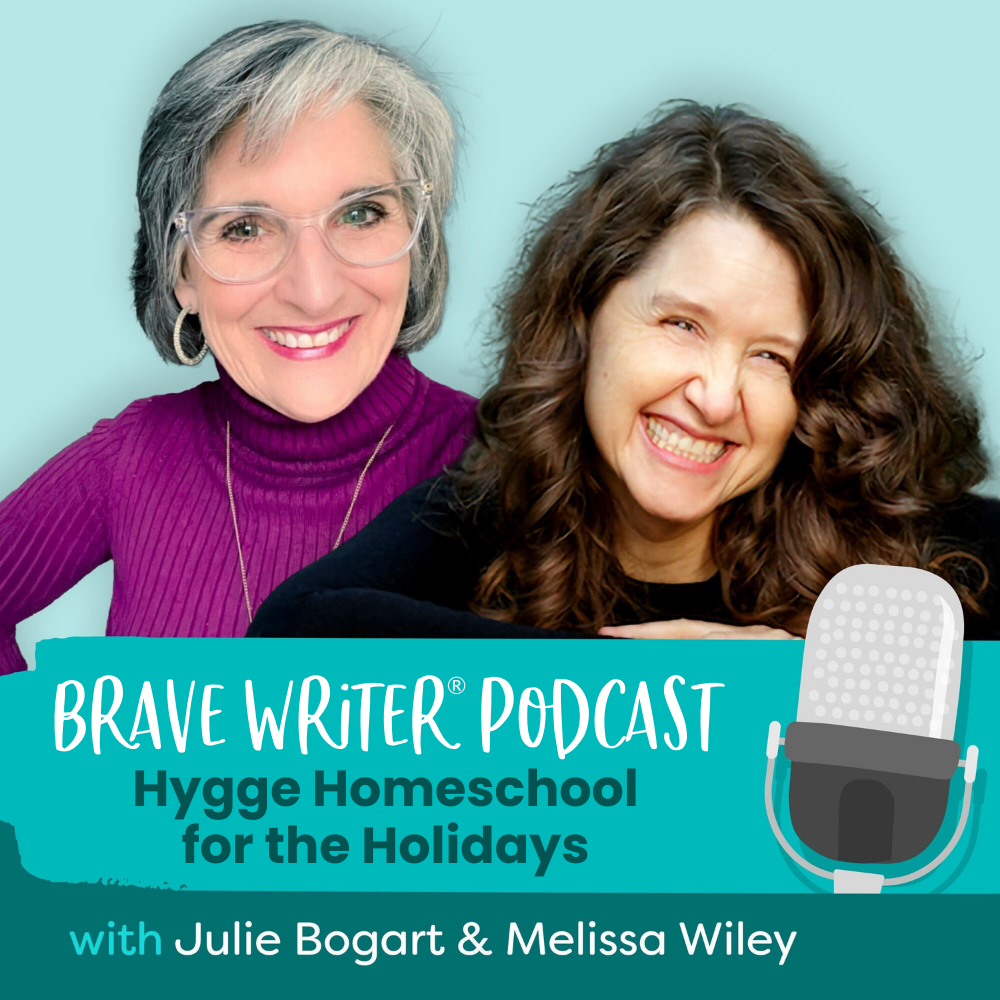
As the leaves turn and the days shorten, there’s a distinct shift in the air – it’s the cozy season, a time for warmth, reflection, and connection. This season, we’re revisiting one of our favorite conversations about embracing the Danish concept of hygge (pronounced “hoo-ga”) in our homeschooling journey. Hygge is all about creating a warm atmosphere and enjoying the good things in life with good people. It’s the warmth of morning light streaming through the window, the comfort of a hot cup of cocoa, the joy of a shared story.
In this replayed Brave Writer podcast episode, we delve into how hygge can transform the homeschooling experience. As the season changes, so does the rhythm of our homes and our approach to education. It’s a time to slow down, to savor, and to connect more deeply with our children through learning and play.
Go here for the complete Show Notes.
Resources
- Start a free trial of CTCmath.com to try the math program that’s sure to grab and keep your child’s attention!
- English Tea Store: englishteastore.com
- Read: The Art of Noticing by Rob Walker
- Read: Outside Lies Magic by John Stilgoe
- Some of the games mentioned:
- Hero Kids: https://www.heroforgegames.com/hero-kids/
- Amazing Tales: https://amazing-tales.net/
- Expedition (free pdf): https://expeditiongame.com/print-and-play (for all ages)
- Your Very Own Village (free pdf): https://www.onwardheroes.com/yourveryownvillage
- MouseGuard RPG: https://www.mouse-guard.net/rpg
- Sign up for our Text Message Pod Ring to get podcast updates and more!
- Send us podcast topic ideas by texting us: +1 (833) 947-3684
- Want help getting started with Brave Writer? Go to bravewriter.com/getting-started
- Sign up for the Brave Writer newsletter to learn about all of the special offers we’re doing in 2022 and you’ll get a free seven-day Writing Blitz guide just for signing up: https://go.bravewriter.com/writing-blitz
Connect with Julie
- Instagram: @juliebravewriter
- Threads: @juliebravewriter
- Bluesky: @bravewriter.com
- Facebook: facebook.com/bravewriter
Connect with Melissa
- Website: melissawiley.com
- Substack: melissawiley.substack.com
- Instagram: @melissawileybooks
- Bluesky: @melissawiley.bsky.social
Produced by NOVA




















